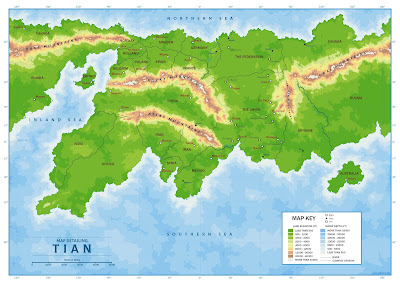EARLY CIVILISATION AND THE DEVELOPMENT OF NATIONS.
In the 1890s of my world, scientists have yet to fully understand the origins of the human species. All that is known is that civilisation largely developed around the northern shores of the Inland Sea. That said early seafarers, mainly from Britain, did discover civilisations in Russia to the west and China to the south. Generally speaking however the vast central area of the continent remained unoccupied and unexplored. Britain, as the only island in the Inland Sea, has always been by far the dominant maritime nation. Over the centuries the various Inland Sea coastal civilisations moved eastward to the north of the Rocky Mountains and developed a number of unique national identities.
However over the past several hundred years there has been a great deal of religious persecution in many of these nations. This prompted a number of emigrations by various peoples over the years to some of the unexplored regions of the continent in order to establish new nations free from the old ways. Each of these new nations has developed a unique way of life reflecting both their aspirations and the characteristics of their original civilisation.
The very first of the new countries founded by migrants from the north was Mexico. The people mostly came from Spain and initially settled along the coast. However over the years as they expanded inland they came into contact with a new civilisation, previously unknown, in the north west. These new people, the Arabs, and the Mexicans each found the other disagreeable and quickly established borders to keep themselves apart. Some years later the British started to establish trading posts and maritime support bases along the coasts of India and Africa in support of their discovery of a new huge unpopulated island they called Australia. This island proved to have vast natural resources and prompted the British to start the colonisation of the island.
The other very early new nation was Ukraine to the far west of Russia. This nation was founded yet again by migrants seeking to escape persecution in Russia. However they came in very small numbers and travelled thousands of miles eventually settling in the south where they found rich agricultural lands far away from the influence of Russia. Somewhat later explorers from both France and Germany moved, with great difficulty, across the River Rhine and found a seemingly endless land stretching away to the east and south. Very slowly over the years a thinly populated farming community developed across the north of this area in an easterly direction. Over those years the area became known as a sort of colony of France and Germany with the people seeing themselves more as citizens of those countries rather than having an identity of their own. Throughout those years however the huge lands to the south remained unexplored and unoccupied.
Around two hundred years ago a convoy of British settlers bound for Australia were shipwrecked on the coast of the Southern Sea about half way between Mexico and Ukraine. Most of the settlers survived and with the stores and materials recovered from the wrecked ships were able to establish a substantial settlement in the rich farming lands near present day Miami. Over the following years the settlements grew and were supplemented by many additional British and even some other migrants from the counties round the Inland Sea. These new communities flourished and rapidly spread north , fanning out into vast tracts of exceedingly rich country with an abundance of natural resources. Over time the population focus moved north and many new towns and cities were established far from the coast which became a sort of backwater. A population explosion began in this rich land and industrial development started. After a period of about 150 years a sense of national identity was growing rapidly and the first moves began to establish a nation and firm up the borders with neighbouring countries.
As development moved north, links with Britain faded and the new nation became increasingly self sufficient and isolationist. This coincided with contact being established with the Mexicans who had retained their links to the rest of the world and offered the possibility of limited trading opportunities. Cordial relations were established and a border was locally agreed along the Rio Grande River. Limited contact was also established with Ukraine although a formal border was not established as neither side found the border region worthy of development to any large degree as the area was mostly scrubland and arid. Further north contact was briefly made with China in a pass through the Rocky Mountains. Neither side found the other agreeable and tensions quickly arose, both sides quickly deciding independently to avoid settlement anywhere near the other. Finally contact was established in the far north with the French/German colony. Yet again the two sides soon developed a mutual hostility based mostly on the French and Germans resenting the establishment of a potentially dynamic new nation so close to their somewhat underdeveloped colony. No agreement on a border was made and again both sides decided separately to discourage settlement anywhere near the other.
So the scene is set for the next chapter which will see the formal establishment of a new nation and the approach of the War of Independence. If you have read this far, please let me have your comments, is this going the right way for you to want to read more ????







